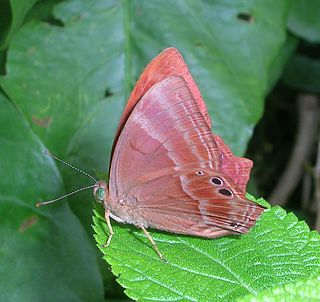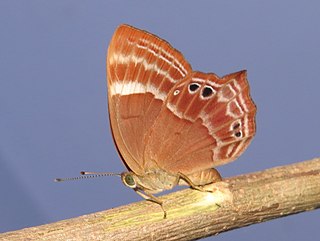
Danaus genutia, the common tiger, is one of the common butterflies of India. It belongs to the "crows and tigers", that is, the Danainae group of the brush-footed butterflies family. The butterfly is also called striped tiger in India to differentiate it from the equally common plain tiger, Danaus chrysippus. The species was first described by Pieter Cramer in 1779.

Abisara echerius, the plum Judy, is a small but striking butterfly found in Asia belonging to the Punches and Judies family (Riodinidae). It is difficult to distinguish it from Abisara bifasciata.

Graphium sarpedon, the common bluebottle or blue triangle in Australia, is a species of swallowtail butterfly that is found in South and Southeast Asia, as well as eastern Australia. There are approximately sixteen subspecies with differing geographical distributions.

Spalgis epius, the apefly, is a small butterfly found in the Indomalayan realm that belongs to the lycaenids or blues family. It gets its name from the supposed resemblance of its pupa to the face of an ape.

Kaniska canace, the blue admiral, is a nymphalid butterfly, the only species of the genus Kaniska. It is found in south and southeast Asia.

Ionolyce helicon, the pointed lineblue, or bronze lineblue, is a small butterfly found in the Indomalayan realm that belongs to the lycaenids or blues family.

Pratapa deva, the white royal, is a lycaenid or blue butterfly found in the Indomalayan realm. The species was first described by Frederic Moore in 1857.

Rapala lankana, the Malabar flash, is a species of lycaenid or blue butterfly found in South India and Sri Lanka. It was first described by Frederic Moore in 1879.

Hasora anura, the slate awl, is a species of hesperid butterfly found in Asia. In India it is found in Sikkim and the Khasi Hills.

Nordstromia is a genus of moths belonging to the subfamily Drepaninae.

Nordstromia japonica is a species of moth belonging to the subfamily Drepaninae. It is found in Japan and China.
Nordstromia lilacina is a moth in the family Drepanidae. It is found in India and mainland China. Reports from Taiwan refer to Nordstromia semililacina.

Abisara bifasciata, the double-banded Judy or twospot plum Judy, is a butterfly in the family Riodinidae. It is found in Asia.
Collix hypospilata is a moth in the family Geometridae. It was described by Achille Guenée in 1857. It is endemic to Sri Lanka.

Agnidra discispilaria is a moth in the family Drepanidae. It was described by Frederic Moore in 1867. It is found in north-eastern India, Sikkim and Thailand.

Nordstromia bicostata is a moth in the family Drepanidae. It was described by George Hampson in 1912. It is found in Sikkim in India, Sichuan in China, Nepal and northern Myanmar.
Nordstromia humerata is a moth in the family Drepanidae. It was described by Warren in 1896. It is found in north-eastern India.
Nordstromia undata is a moth in the family Drepanidae. It was described by Watson in 1968. It is found in Yunnan, China.

Nordstromia vira is a moth in the family Drepanidae. It was described by Frederic Moore in 1866. It is found in Myanmar, India, Nepal and China.
Trisula variegata is a moth of the family Noctuidae first described by Frederic Moore in 1858. It is found in India, Sri Lanka, Nepal, Thailand, South China, Indonesia and the Philippines.












